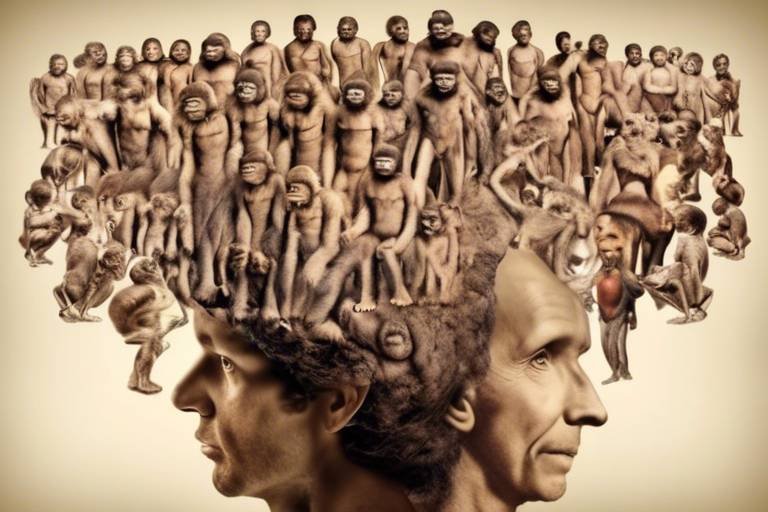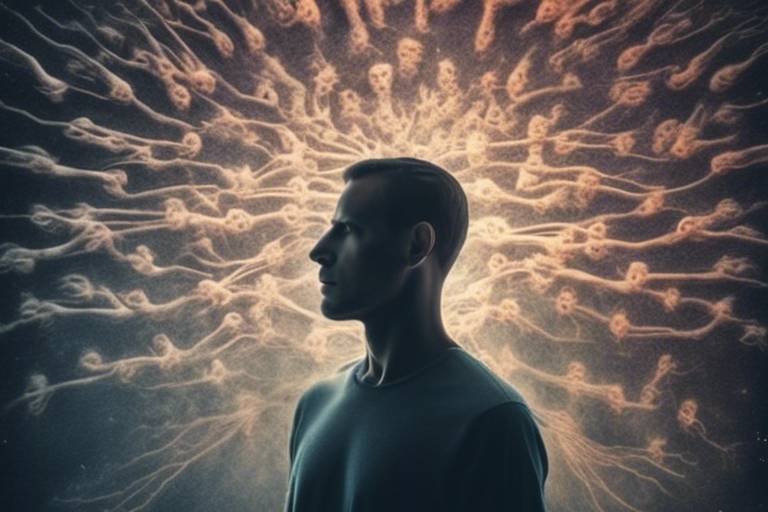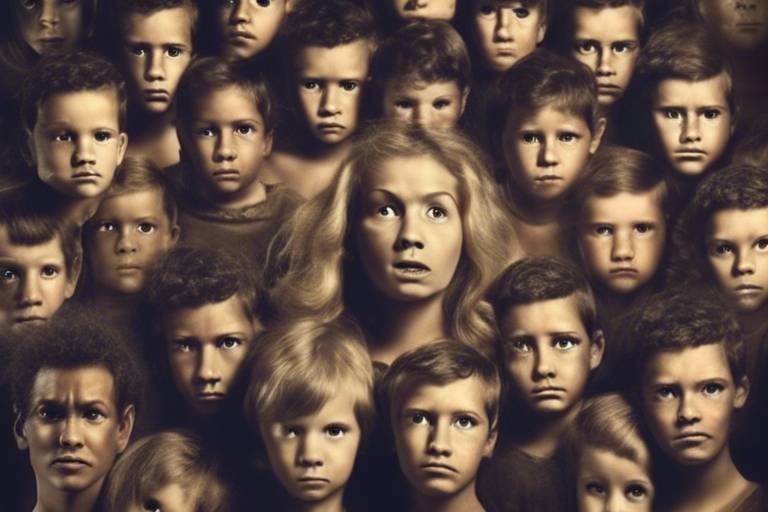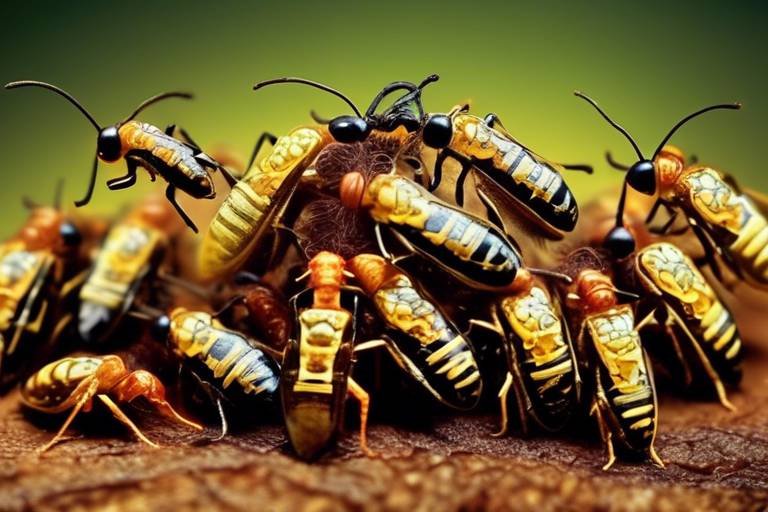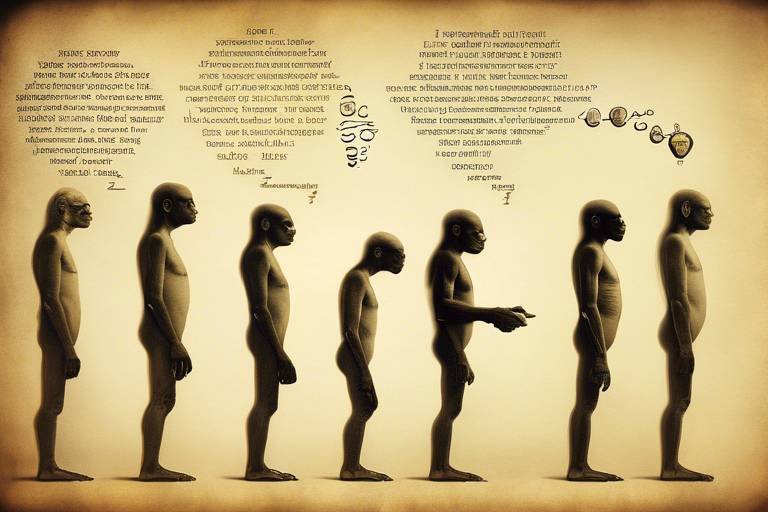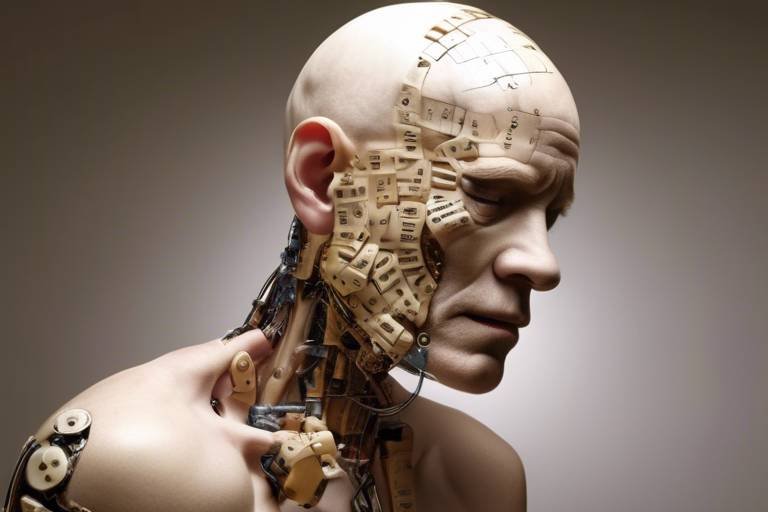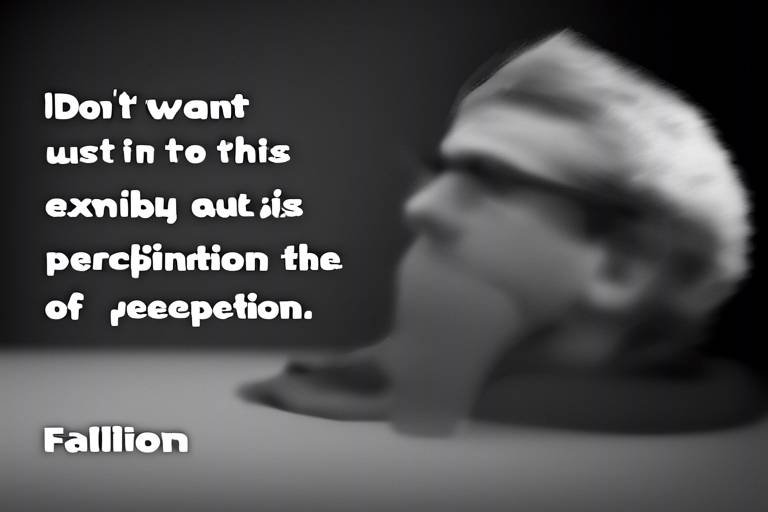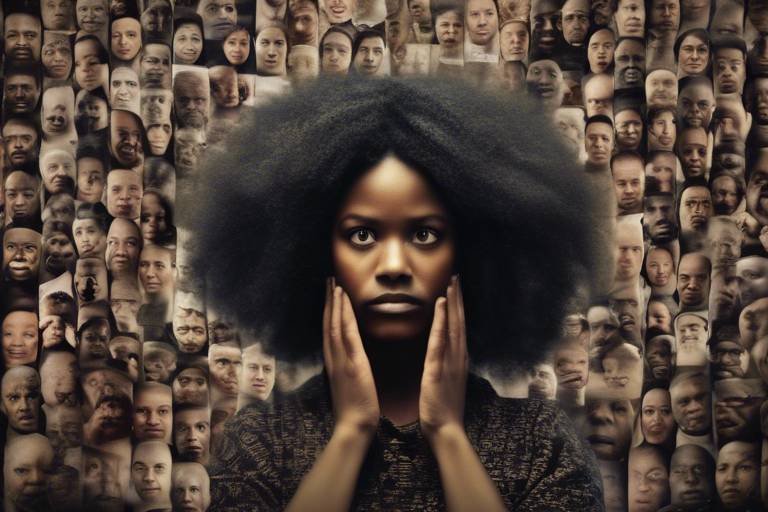The Role of Mind in Human Evolution
The journey of human evolution is a fascinating tale, woven intricately with the threads of cognitive development. Our minds have not only adapted but have also driven the very essence of what it means to be human. Imagine a time when early humans roamed the earth, facing challenges that seemed insurmountable. It was their ability to think, reason, and innovate that allowed them to survive and thrive in a world filled with danger and uncertainty. This article explores how our cognitive abilities have shaped our evolution, influencing everything from survival strategies to the formation of complex social structures and cultural advancements.
As we delve deeper into this complex relationship between mind and evolution, we will uncover the layers of how problem-solving, communication, and adaptability have been pivotal in our development as a species. The evolution of our cognitive abilities is not just a story of survival; it is a narrative of how our minds have enabled us to forge connections, build societies, and create cultures that reflect our shared experiences and aspirations.
So, what exactly does it mean for our minds to have played such a crucial role in human evolution? To start, consider this: our cognitive abilities are like the engines of a car—without them, we would be stuck in neutral, unable to move forward. They drive our ability to learn from our environment, adapt to new challenges, and communicate effectively with one another. In the following sections, we will explore how these abilities have evolved over time and how they continue to shape our existence today.
In essence, understanding the role of the mind in human evolution is not just an academic exercise; it is a journey into the very heart of what it means to be human. As we navigate through the various aspects of this relationship, we will uncover the profound impact that cognitive development has had on our survival, our social structures, and our cultural identities. Join us as we embark on this enlightening exploration of the mind's role in the grand tapestry of human evolution.
Cognitive abilities have evolved significantly over time. This section discusses how these advancements have contributed to problem-solving, communication, and adaptability in early humans.
Social structures play a crucial role in human evolution. Here, we analyze how the development of complex societies influenced cognitive functions and interpersonal relationships.
Cooperation among early humans was essential for survival. This subsection examines how collaborative efforts fostered cognitive growth and social bonding.
Language emerged as a vital tool for communication. This part discusses how the evolution of language facilitated social interactions and enhanced cognitive abilities.
Cultural practices and rituals significantly shaped human cognition. This section explores how these elements contributed to the development of shared knowledge and social cohesion.
Environmental challenges have influenced cognitive evolution. This segment discusses how adapting to different habitats led to the development of various mental strategies.
Technological progress has been intertwined with cognitive evolution. This section highlights how innovations have shaped human thought processes and problem-solving skills.
The use of tools marks a significant cognitive leap. Here, we explore how early tool-making influenced brain development and social organization.
Artistic expression reflects cognitive complexity. This subsection examines how art and symbolism have played a role in human evolution and cultural identity.
- How did cognitive abilities impact early human survival?
Cognitive abilities allowed early humans to solve problems, communicate effectively, and adapt to their environment, which were crucial for survival. - What role did language play in human evolution?
Language facilitated social interactions, enabling humans to share knowledge and collaborate more effectively, thus enhancing cognitive development. - How have technological advancements influenced human cognition?
Technological innovations have shaped thought processes, allowing for more complex problem-solving and creative expression.

The Evolution of Cognitive Abilities
The journey of human evolution is not just a story of physical changes; it’s also a tale of the mind. Over millions of years, our cognitive abilities have evolved dramatically, enabling us to solve problems, communicate effectively, and adapt to ever-changing environments. This evolution of the mind has been pivotal in shaping our survival strategies and social structures. Imagine early humans standing on the brink of survival, armed not just with primitive tools but with the ability to think critically and communicate complex ideas. This cognitive leap was crucial, allowing them to navigate challenges in their environment and form deeper social connections.
As we delve deeper into this fascinating evolution, we can see that early humans developed a range of cognitive skills that were essential for their survival. These advancements included:
- Problem-Solving: The ability to analyze situations and come up with effective solutions was vital for hunting, gathering, and avoiding predators.
- Communication: Developing basic forms of communication allowed early humans to share knowledge, coordinate group activities, and teach one another.
- Adaptability: Cognitive flexibility enabled early humans to adjust their behaviors and strategies based on environmental changes.
One of the most significant aspects of cognitive evolution is the development of the brain itself. As our ancestors faced various challenges, their brains expanded in size and complexity. This growth was not merely about having a bigger brain; it was about enhancing the connections within it. The intricate network of neurons allowed for more sophisticated thought processes and behaviors. For instance, early humans learned to use tools not just for survival but also as a means of expressing creativity and social identity.
Furthermore, cognitive abilities didn’t evolve in isolation. They were influenced by various factors, including the environment, social interactions, and the necessity for survival. The interplay between these elements created a rich tapestry of cognitive development. For example, as early humans began to live in larger groups, the need for social cohesion and cooperation became paramount. This led to the evolution of more complex social structures, which in turn required enhanced cognitive skills to navigate relationships and hierarchies.
Interestingly, the evolution of cognitive abilities also paved the way for the emergence of language. Language is not just a tool for communication; it’s a vehicle for thought. The ability to articulate ideas and emotions allowed our ancestors to share experiences, pass down knowledge, and build cultures. This linguistic development marked a turning point in human evolution, as it provided a framework for collective memory and social bonding.
In summary, the evolution of cognitive abilities has been a cornerstone of human development. It has enabled us to adapt, innovate, and thrive in diverse environments. As we continue to explore our cognitive heritage, it becomes clear that our minds have not only shaped our past but will also influence our future. The journey of the mind is ongoing, and understanding its evolution can provide valuable insights into what it means to be human.

The Impact of Social Structures
The evolution of social structures has played a pivotal role in shaping human cognition and behavior. As early humans began to form groups, the need for communication, cooperation, and organization became paramount. This shift from solitary existence to living in complex societies marked a significant turning point in our evolutionary journey. Just as a single thread can weave into a rich tapestry, the intricate connections between individuals in a society have led to the development of more sophisticated cognitive abilities.
Initially, humans lived in small, tight-knit groups where survival depended on mutual support and resource sharing. Over time, these groups expanded, leading to the formation of larger communities with more intricate social hierarchies. The emergence of these complex societies not only influenced how people interacted but also enhanced their cognitive functions. For instance, individuals had to navigate social dynamics, understand group roles, and develop strategies for conflict resolution, all of which required advanced mental processing.
One of the most fascinating aspects of social structures is the concept of cooperation. Early humans who worked together were more likely to survive and thrive. This collaboration fostered not just a sense of community but also pushed cognitive boundaries. When individuals pooled their knowledge and skills, they created a collective intelligence that far surpassed what any single person could achieve alone. It’s like a sports team where each player brings their unique strengths to the game, leading to a greater chance of victory.
Cooperation among early humans was essential for survival. Think about it: if you were stranded on a deserted island, would you rather be alone or have a group of friends with you? The same principle applies to our ancestors. By working together, they could hunt more effectively, gather resources, and protect one another from predators. This necessity for teamwork not only enhanced their chances of survival but also encouraged the development of social bonding and communication skills.
As these early social structures evolved, language began to emerge as a crucial tool for facilitating cooperation. The ability to convey thoughts, ideas, and emotions allowed individuals to coordinate their efforts more efficiently. Imagine trying to organize a group project without being able to talk to your teammates! Language became the glue that held these complex social systems together.
The evolution of language is one of the most significant milestones in human development. It transformed the way individuals interacted and shared knowledge. With language, humans could express abstract concepts, share experiences, and pass down information from one generation to the next. This ability to communicate not only strengthened social bonds but also enhanced cognitive capabilities, enabling individuals to think critically and engage in problem-solving.
Another important aspect of social structures is the role of rituals and culture in shaping human cognition. Early humans engaged in various cultural practices, from hunting rituals to communal celebrations, which fostered a sense of identity and belonging. These shared experiences contributed to the development of collective memory and social cohesion. Just as a well-rehearsed dance performance captivates an audience, cultural rituals captivated communities, reinforcing social ties and enhancing cognitive development.
As cultures evolved, so did the complexity of social interactions. The exchange of ideas, beliefs, and customs enriched cognitive processes, allowing for greater innovation and creativity. In essence, the interplay between social structures and cognitive development is like a dance, where each partner influences the other's movements, leading to a more intricate and harmonious performance.
In conclusion, the impact of social structures on human evolution cannot be overstated. From fostering cooperation and collaboration to enhancing language development and cultural practices, these structures have significantly influenced our cognitive abilities. As we continue to navigate the complexities of modern society, understanding the roots of our social nature can help us appreciate the profound connections that bind us together.
- How did social structures influence human evolution? Social structures facilitated cooperation, communication, and cultural practices, which enhanced cognitive development and survival strategies.
- What role did language play in social structures? Language emerged as a vital tool for communication, allowing individuals to coordinate efforts and share knowledge, thus strengthening social bonds.
- How do rituals and culture impact cognition? Cultural practices and rituals foster a sense of identity and belonging, contributing to collective memory and enhancing cognitive processes.
- What is the significance of cooperation in early human societies? Cooperation was essential for survival, as it allowed early humans to work together for hunting, gathering, and protection, leading to cognitive growth.

Cooperation and Collaboration
Cooperation and collaboration among early humans were not just beneficial; they were essential for survival. Imagine a world where individuals had to fend for themselves, hunting for food, finding shelter, and protecting themselves from predators. It would have been a daunting task, right? But when humans began to work together, something remarkable happened. They formed bonds, shared knowledge, and developed strategies that significantly enhanced their chances of survival.
In those early days, cooperation was like the glue that held communities together. Early humans learned that by pooling their resources and skills, they could tackle challenges much more effectively than if they acted alone. For instance, a group of hunters could coordinate their efforts to take down larger prey, which would provide food for the entire community. This not only ensured a steady food supply but also fostered a sense of belonging and mutual reliance among individuals.
Furthermore, collaboration extended beyond just hunting. It played a vital role in the gathering of resources, building shelters, and even raising children. When people worked together, they could divide tasks based on individual strengths, making the process more efficient. This division of labor allowed for specialization, where some became expert toolmakers while others focused on foraging or caregiving.
To illustrate the significance of cooperation, consider the following key benefits:
- Enhanced Problem-Solving: When diverse minds come together, they bring different perspectives and ideas. This variety can lead to innovative solutions that a single individual might not have considered.
- Strengthened Social Bonds: Collaborating fosters trust and camaraderie. As people worked side by side, they built relationships that were crucial for emotional support and community stability.
- Increased Efficiency: By sharing responsibilities, tasks could be completed faster and more effectively, allowing communities to thrive and grow.
Moreover, the act of cooperating didn’t just benefit the immediate community; it laid the groundwork for complex social structures that would emerge over time. As humans began to form larger groups, the need for effective communication and coordination became paramount. This is where the seeds of language and social norms began to take root, further enhancing collaboration among individuals.
In essence, cooperation and collaboration were not merely survival strategies; they were catalysts for cognitive growth and social evolution. They transformed the way early humans interacted with one another and their environment, paving the way for the intricate societies we see today. The importance of working together cannot be overstated; it is a fundamental aspect of what it means to be human, shaping our evolution in profound ways.
Q1: How did cooperation affect early human survival?
A1: Cooperation allowed early humans to pool resources, share knowledge, and tackle challenges more effectively, significantly enhancing their chances of survival.
Q2: What role did collaboration play in social structures?
A2: Collaboration fostered social bonds and trust, leading to the development of complex social structures and communities.
Q3: How did cooperation influence cognitive development?
A3: Working together brought diverse perspectives, enhancing problem-solving abilities and leading to cognitive growth among early humans.

Language Development
The evolution of language is one of the most remarkable milestones in human history, acting as a catalyst for social interaction and cognitive growth. Imagine a world where communication is reduced to mere gestures and grunts; it would be a challenging existence, wouldn't it? Language transformed the way early humans connected with one another, allowing them to share experiences, express emotions, and convey complex ideas. This development was not merely about creating sounds; it was about forging a bond that would enhance survival and foster community.
As early humans began to articulate their thoughts, they unlocked a new realm of possibilities. The ability to communicate effectively meant that they could collaborate on hunting strategies, share knowledge about food sources, and warn each other of impending dangers. In essence, language became a powerful tool that strengthened social ties and improved survival rates. It was like adding a new layer of sophistication to human interaction, enabling individuals to work together more efficiently and harmoniously.
Moreover, the development of language was not a linear process; it was a complex evolution influenced by various factors, including environmental needs and social dynamics. For instance, in smaller groups, simpler forms of communication might have sufficed, but as human societies grew larger and more intricate, the demand for a more nuanced language emerged. This led to the creation of diverse dialects and languages, each uniquely tailored to the needs of its speakers. Just like a tree branching out, language evolved into a multitude of forms, reflecting the rich tapestry of human experience.
One of the most fascinating aspects of language development is its link to cognitive abilities. Researchers have found that as language became more sophisticated, so did the brain's capacity for abstract thinking and problem-solving. This relationship can be likened to a dance; as one partner leads, the other follows, creating a beautiful synergy. Language not only allowed humans to articulate their thoughts but also shaped the very way they thought. The more complex the language, the more intricate the cognitive processes became, paving the way for advancements in art, science, and culture.
To illustrate the impact of language on cognitive development, consider the following table that highlights key milestones in language evolution and their corresponding effects on human cognition:
| Milestone | Description | Impact on Cognition |
|---|---|---|
| Basic Sounds | Initial vocalizations used for basic communication | Enabled simple social interactions |
| Symbolic Language | Development of words representing objects and ideas | Facilitated abstract thinking and sharing of knowledge |
| Grammar and Syntax | Introduction of structured language rules | Enhanced complexity of thought and reasoning |
| Written Language | Creation of symbols to represent spoken language | Allowed for the preservation and transmission of knowledge |
In conclusion, the development of language can be seen as a cornerstone of human evolution. It not only enhanced communication but also played a pivotal role in shaping our cognitive abilities and societal structures. Just as a river carves its path through the landscape, language has shaped the contours of human interaction and thought, leading us to where we are today. As we continue to evolve, one can only wonder how future advancements in language will further influence our cognitive landscapes.
- How did language contribute to human survival?
Language facilitated cooperation and collaboration among early humans, allowing them to share vital information and strategies for survival. - What is the relationship between language and thought?
The development of language has been shown to enhance cognitive abilities, enabling more complex thought processes and problem-solving skills. - Did all human societies develop language in the same way?
No, language evolved differently in various cultures, influenced by environmental needs and social dynamics, leading to a rich diversity of languages.

Rituals and Culture
Rituals and culture are the threads that weave together the fabric of human experience, creating a tapestry rich in meaning and significance. These elements have not only shaped our social interactions but have also profoundly influenced our cognitive evolution. Think about it: from the earliest cave dwellers to modern societies, rituals have served as a way to mark important events, build community, and transmit knowledge across generations. They act as a bridge connecting the past with the present, allowing us to understand our place in the world.
One of the most fascinating aspects of rituals is their ability to foster a sense of belonging and identity. When people engage in communal activities—be it a harvest festival, a rite of passage, or a religious ceremony—they reinforce social bonds that are crucial for survival. This sense of community not only enhances emotional well-being but also stimulates cognitive functions. By participating in rituals, individuals learn to navigate complex social dynamics, improving their communication and problem-solving skills. It's like a mental workout that strengthens the brain's capacity to process social information.
Moreover, rituals often involve storytelling and the sharing of cultural narratives. These stories, passed down through generations, serve as a repository of collective wisdom. They help individuals make sense of their experiences and the world around them. This oral tradition is a powerful tool for cognitive development, as it encourages critical thinking and imagination. Just as a painter uses colors to create a masterpiece, humans use stories to paint their reality, shaping their understanding of existence.
Another dimension to consider is the role of rituals in emotional regulation. Engaging in structured activities can provide comfort and stability, especially in times of uncertainty. For instance, think about how many cultures have rituals surrounding death or mourning. These practices not only honor the deceased but also help the living process their grief. By creating a safe space for emotional expression, rituals contribute to mental health and cognitive resilience.
In today’s fast-paced world, we often overlook the importance of these ancient practices. However, as we face new challenges—be it climate change, social unrest, or technological disruptions—the wisdom embedded in rituals can offer valuable insights. They remind us of our shared humanity and the importance of community. It's a call to return to our roots, to embrace the rituals that have guided humanity through the ages.
To summarize, rituals and culture are not mere remnants of the past; they are dynamic forces that continue to shape our cognitive evolution. They enhance social cohesion, foster emotional well-being, and stimulate intellectual growth. As we navigate the complexities of modern life, let us not forget the power of these ancient practices to enrich our minds and strengthen our communities.
- What are rituals? Rituals are structured activities or ceremonies that hold significant meaning within a culture or community.
- How do rituals influence cognitive development? Rituals enhance cognitive functions by improving social interaction, fostering emotional regulation, and encouraging storytelling.
- Why are rituals important in modern society? They provide a sense of community, help process emotions, and offer insights into shared human experiences.
- Can rituals evolve over time? Yes, rituals can adapt to changing cultural contexts while retaining their core significance.

Impact of Environment on Cognition
The relationship between our environment and cognitive development is as intricate as a spider's web, with each strand representing a different factor that influences how we think and learn. From the very beginning, early humans faced a myriad of environmental challenges that required them to adapt their cognitive strategies for survival. Imagine living in a world where every day presented new dangers, such as predators lurking in the shadows or unpredictable weather patterns. These challenges didn’t just test physical strength; they pushed the boundaries of the human mind, compelling it to innovate and evolve.
One of the most significant ways the environment has shaped cognition is through the necessity of problem-solving. Early humans had to figure out how to find food, create shelter, and protect themselves from threats. The brain became a powerful tool, constantly analyzing situations and devising strategies. For instance, when faced with a drought, groups had to devise methods to store food or migrate to more hospitable areas. This constant need for adaptation led to the development of complex thought processes and enhanced cognitive abilities.
Moreover, the environment has a profound impact on social cognition. As humans began to form larger communities, understanding social dynamics became crucial. The ability to read social cues and predict the behavior of others was vital for maintaining harmony within groups. This need for social awareness was likely heightened by environmental pressures, where cooperation could mean the difference between life and death. For example, in areas where resources were scarce, those who could navigate social relationships effectively were more likely to thrive.
In addition, the challenges posed by different habitats led to the emergence of diverse mental strategies. For instance, consider how humans living in coastal regions developed skills for fishing and navigation, while those in forested areas became adept at tracking and foraging. Each environment demanded a unique set of cognitive skills, resulting in a rich tapestry of human thought influenced by geographical factors. This adaptability is a testament to the resilience of the human mind, showcasing our ability to learn and evolve in response to the world around us.
To further illustrate this connection, let’s take a look at a table that summarizes the impact of various environmental factors on cognitive development:
| Environmental Factor | Cognitive Impact |
|---|---|
| Resource Availability | Increased problem-solving skills for food acquisition |
| Climate Variability | Enhanced adaptability and planning abilities |
| Social Structures | Improved social cognition and communication skills |
| Geographical Challenges | Diverse mental strategies for survival |
In summary, the environment acts as both a teacher and a challenger to human cognition. It shapes our thought processes, influences our social interactions, and drives our capacity for innovation. Just as a sculptor chisels away at a block of marble to reveal a masterpiece, the environment continuously molds our cognitive abilities, allowing us to adapt, survive, and thrive in an ever-changing world.
- How does the environment influence cognitive development?
The environment presents challenges that require problem-solving, adaptability, and social awareness, all of which enhance cognitive abilities. - What role does social structure play in cognition?
Social structures necessitate understanding social dynamics, which enhances communication and social cognition. - Can environmental changes affect our thought processes?
Yes, changing environments can lead to the development of new mental strategies and problem-solving skills.

Technological Advancements
The journey of human evolution is intricately linked to our ability to innovate and adapt through . From the early days of rudimentary tool-making to the sophisticated digital age we live in today, each leap in technology has not only transformed our environment but has also reshaped the very fabric of our cognition. Imagine a time when early humans crafted tools from stone; this was not merely about survival but a profound cognitive milestone that paved the way for future innovations. These advancements have allowed us to solve complex problems, communicate more effectively, and navigate the challenges of our surroundings with greater ease.
As we delve deeper into this fascinating relationship, it becomes clear that technology has always been a catalyst for cognitive evolution. For instance, the creation of simple tools like hand axes or fishing spears required a level of planning, foresight, and dexterity that showcased early humans' growing mental capabilities. This evolution of tool use marked a significant cognitive leap, prompting the brain to adapt and grow in response to new challenges. Each tool developed was not just a physical object; it represented a new way of thinking, a shift in perspective that allowed humans to manipulate their environment in ways previously thought impossible.
Moreover, as technology advanced, so did our social structures. The rise of agriculture, for example, transformed nomadic tribes into settled communities. This shift necessitated new forms of organization and cooperation, which in turn fostered enhanced cognitive functions. The need to manage resources, plan for the future, and build relationships within larger groups pushed our cognitive abilities to new heights. As societies became more complex, so did the technologies they developed. This is where the interplay between mind and machine becomes particularly intriguing.
Consider the impact of the printing press, a revolutionary technological advancement that changed the landscape of human thought. By making information more accessible, it not only democratized knowledge but also encouraged critical thinking and literacy. This shift allowed individuals to engage with ideas in ways that were previously unimaginable. The ripple effect of such innovations is profound, leading to the Renaissance and the Enlightenment, periods characterized by explosive growth in art, science, and philosophy.
Today, we stand on the brink of another technological revolution with the rise of artificial intelligence and digital communication. These advancements are reshaping our cognitive processes once again. We find ourselves in a world where information is at our fingertips, yet this convenience raises questions about our cognitive reliance on technology. Are we enhancing our cognitive abilities, or are we risking a decline in critical thinking skills? This ongoing dialogue underscores the importance of understanding how technology influences our minds.
As we reflect on the past and look to the future, it's essential to recognize that technological advancements are not merely tools; they are extensions of our cognitive capacities. Each innovation invites us to think differently, adapt our behaviors, and even redefine what it means to be human. The relationship between technology and cognition is a dynamic interplay that continues to shape our evolution.
- How have technological advancements influenced human evolution?
Technological advancements have significantly shaped human evolution by enhancing our cognitive abilities, facilitating complex social structures, and enabling innovative problem-solving. - What role did tool-making play in cognitive development?
Tool-making marked a significant cognitive leap, showcasing early humans' ability to plan, create, and adapt, which in turn influenced brain development and social organization. - Are modern technologies affecting our critical thinking skills?
Yes, while modern technologies provide easy access to information, they also raise concerns about our reliance on them, potentially impacting our critical thinking skills. - How does language development relate to technological advancements?
Language development has been crucial for communication and collaboration, which are essential for the sharing of technological knowledge and innovations across generations.

Tool Use and Development
When we think about the dawn of humanity, one of the most striking features that set us apart from other species is our ability to create and use tools. This ability didn't just appear overnight; it was a significant cognitive leap that marked a turning point in our evolutionary journey. Imagine early humans, faced with the harsh realities of their environment, not just surviving but actively shaping their world through the clever use of materials at hand. This innovative spirit was crucial for our ancestors, allowing them to manipulate their surroundings and enhance their survival chances.
From the earliest stone tools to the sophisticated implements we use today, the development of tools has been a driving force in human evolution. These tools were more than just objects; they represented a complex interplay of cognition, creativity, and social collaboration. Early humans crafted tools for various purposes, including hunting, gathering, and processing food. The act of making tools required not only physical dexterity but also advanced planning and problem-solving skills. This process of creation and refinement of tools can be seen as a reflection of our evolving cognitive abilities.
Consider this: when early humans began to use tools, they weren't merely extending their physical capabilities; they were also enhancing their cognitive frameworks. The brain's structure began to adapt, developing areas responsible for fine motor skills and spatial awareness. This adaptation can be likened to a muscle that strengthens with use. The more tools were used, the more the brain adapted to handle the complexities of tool-making and usage. Over time, this led to an intricate relationship between tool use and cognitive development, where each influenced the other in a continuous cycle of growth.
Moreover, the social aspect of tool use cannot be overlooked. As humans began to form groups, the sharing of knowledge about tool-making became essential. Imagine a scenario where one individual discovers a more efficient way to create a spear. This knowledge would not only benefit the individual but would also spread throughout the group, enhancing the collective skill set. This collaborative learning process fostered a sense of community, reinforcing social bonds and paving the way for the development of more complex societies.
In summary, tool use and development were not just about survival; they were a catalyst for cognitive evolution. As our ancestors crafted and utilized tools, they engaged in a process that shaped both their minds and their social structures. This relationship between tools and cognition highlights a fundamental aspect of what it means to be human: the ability to innovate, adapt, and thrive in an ever-changing environment.
- How did tool use impact early human societies?
Tool use allowed early humans to hunt more effectively, gather food more efficiently, and protect themselves from predators. This led to the formation of communities and the sharing of knowledge, which strengthened social ties. - What types of tools did early humans create?
Early humans created a variety of tools, including stone knives, spears, and axes. As time progressed, they developed more specialized tools for tasks such as sewing and woodworking. - Did tool-making influence brain development?
Yes, the process of making and using tools required advanced cognitive skills, which likely contributed to changes in brain structure and function over time. - How does tool use relate to modern technology?
The principles of tool use have evolved into the technological innovations we see today, reflecting our ongoing relationship with our environment and our capacity for creativity and problem-solving.

Art and Symbolism
Art and symbolism are not just mere expressions of creativity; they are profound reflections of the cognitive evolution of humans. From the earliest cave paintings to modern digital art, the journey of artistic expression showcases the intricate relationship between our minds and the world around us. Imagine walking into a dimly lit cave and being greeted by vivid images of animals, hunting scenes, and abstract symbols. These artworks were not just decorations; they were a language of their own, conveying stories, beliefs, and emotions that transcended time and space.
As early humans began to create art, they were also developing a deeper understanding of their environment and their place within it. Each brush stroke or chiseled line represented a cognitive leap—an ability to conceptualize, plan, and execute complex ideas. This artistic endeavor required not only creativity but also advanced problem-solving skills. For instance, the choice of materials, the techniques employed, and the depiction of subjects all demanded a level of foresight and understanding that was crucial for survival.
Moreover, art served as a powerful tool for social cohesion. It was a means of communication that fostered connections among individuals and groups. Through shared artistic experiences, early humans could strengthen bonds and build a sense of community. This is where symbolism comes into play; symbols can encapsulate entire narratives or cultural values in a single image. For example, a simple circle might represent unity, while a spiral could signify the journey of life. Such symbols became the building blocks of cultural identity, allowing groups to express their collective experiences and beliefs.
Let's take a moment to consider how art and symbolism have evolved over time. The table below illustrates some key milestones in the development of art and its cognitive implications:
| Period | Artistic Expression | Cognitive Implications |
|---|---|---|
| Prehistoric | Cave Paintings | Development of visual representation and storytelling |
| Ancient Civilizations | Hieroglyphs and Pottery | Advancement in symbolic thought and communication |
| Renaissance | Realism and Perspective | Enhanced understanding of spatial relationships and human emotion |
| Modern Era | Abstract Art | Exploration of subjective experience and complex concepts |
In conclusion, art and symbolism are not just reflections of human creativity; they are essential components of our cognitive evolution. They demonstrate how our minds have developed the capacity to create, communicate, and connect with one another. As we continue to evolve, so too will our artistic expressions, serving as a testament to the ever-changing landscape of human thought and culture.
- What is the significance of art in human evolution?
Art plays a critical role in expressing cognitive capabilities, fostering communication, and building social connections among early humans. - How does symbolism enhance our understanding of culture?
Symbols encapsulate complex ideas and narratives, allowing cultures to convey shared beliefs and experiences succinctly. - Can art influence cognitive development?
Yes, engaging in artistic activities can enhance problem-solving skills, creativity, and emotional intelligence.
Frequently Asked Questions
- How have cognitive abilities evolved in humans?
Cognitive abilities in humans have evolved significantly over millions of years. Initially, early humans relied on basic problem-solving skills for survival. As time progressed, these skills expanded into more complex forms of reasoning, communication, and adaptability. This evolution has allowed humans to navigate their environments more effectively, leading to advancements in social structures and cultural practices.
- What role do social structures play in human evolution?
Social structures are crucial in shaping human evolution. They provide a framework for cooperation and collaboration, which are essential for survival. As humans formed complex societies, cognitive functions improved, allowing for deeper interpersonal relationships and enhanced communication. This social complexity has been a driving force behind cultural advancements and shared knowledge.
- How did language development influence human cognition?
Language development was a game-changer in human evolution. It transformed the way early humans communicated, allowing for the sharing of ideas, experiences, and knowledge. This enhanced communication not only strengthened social bonds but also contributed to cognitive growth, enabling more sophisticated problem-solving and collaborative efforts.
- In what ways did rituals and culture impact cognition?
Cultural practices and rituals have profoundly influenced human cognition. They foster a sense of community and shared identity, which enhances social cohesion. Additionally, these cultural elements encourage the development of shared knowledge and collective memory, allowing humans to build on previous experiences and innovate further.
- How does the environment affect cognitive evolution?
The environment poses various challenges that have shaped cognitive evolution. Different habitats require unique mental strategies for survival. For instance, adapting to changing climates or finding food in diverse ecosystems has led to the development of specialized cognitive skills, enhancing problem-solving abilities and adaptability.
- What is the relationship between technology and cognitive evolution?
Technological advancements are closely linked to cognitive evolution. As humans developed new tools and technologies, their thought processes and problem-solving skills evolved alongside. This relationship has allowed humans to tackle increasingly complex challenges, leading to significant leaps in cognitive capabilities and societal progress.
- How did tool use impact brain development?
The use of tools marked a significant cognitive leap for early humans. Tool-making not only required advanced planning and dexterity but also fostered social organization as individuals collaborated. This interaction between tool use and social structures likely contributed to brain development, enhancing cognitive functions over time.
- What role does art and symbolism play in human evolution?
Art and symbolism are reflections of cognitive complexity in humans. They serve as a means of expression and communication, allowing individuals to convey abstract ideas and emotions. This artistic expression has played a vital role in shaping cultural identity and social cohesion, further driving cognitive evolution as societies developed shared meanings and narratives.

